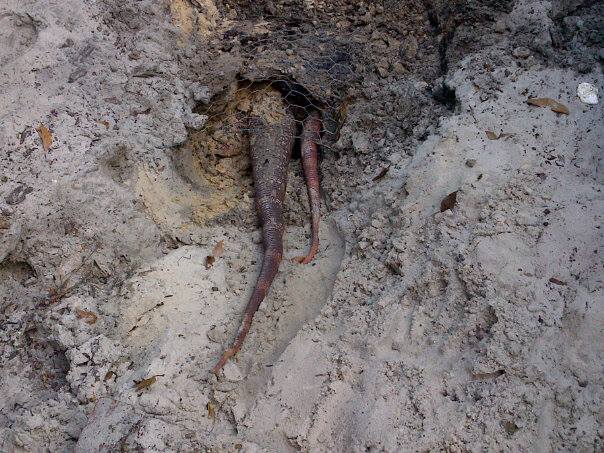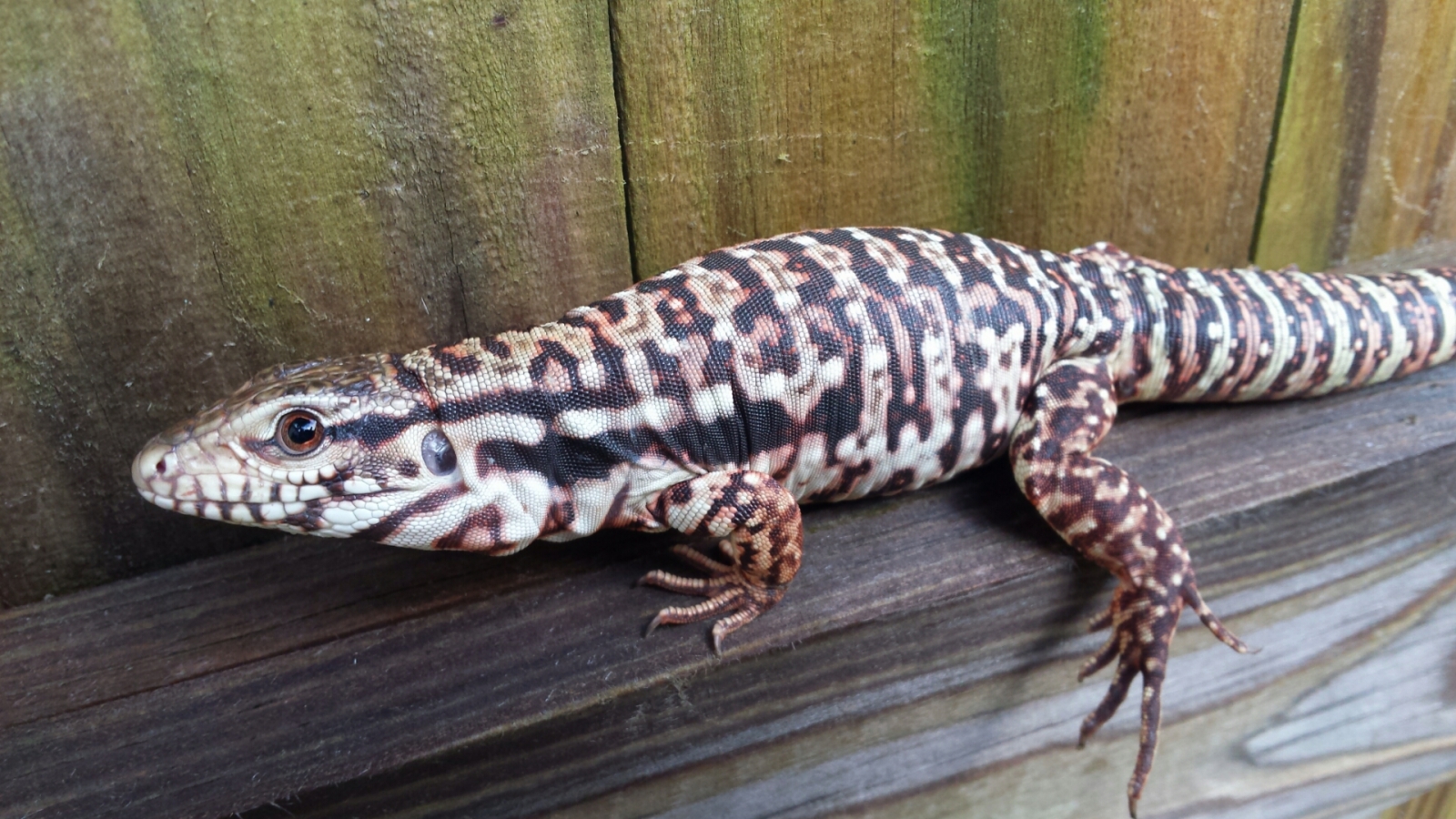Care tips for Salvator Tegus
Updated February 3, 2023
Salvator Species Tegus
Tegus are widely distributed throughout South America where they are tolerant of a variety of habitats. Salvator merianae and Salvator rufescens inhabit the central and western regions of the continent in Brazil, Argentina, Paraguay, Uruguay, and Bolivia. They are an introduced species to Fernando de Noronha Island and the United States, being found in south and central Florida. Salvator tegus are hunted mainly for skins, the commercial pet trade, and human consumption by locals to a lesser degree. In 1999 the export quotas from Argentina and Paraguay were 1,350,000 skins per year. The population of tegus is monitored for decline and the species are CITES-listed Appendix II animals.
laura roberts
Tegus need plenty of open space for basking.
In 2012 a number of tegu species were reclassified from Tupinambis to the previously used genus Salvator. The newly proposed classification comes from a restructuring of the Teiidae family based upon the study of 137 morphological characteristics. The new classification is as follows: Salvator duseni (yellow or Duseni’s tegu), Salvator rufescens (Argentine red tegu), Salvator merianae (giant tegu, Argentine tegu, blue tegu), Tupinambis teguixin (Colombian black and white, gold tegu), Tupinambis longilineus (Rhondonia tegu), Tupinambis palustris (swamp tegu), Tupinambis quadrilineatus (four-lined tegu).
Tegu Availability
Multiple species are found in the international pet trade: Salvator merianae (Argentine or giant black and white tegu, blue tegu), Salvator rufescens (red tegu), and Tupinambis teguixin (Colombian black and white or gold tegu). Tegus are becoming more common in the pet trade each year. Although they make wonderful reptile pets, their large size and expensive appetite should give potential owners cause to pause and think about providing for a large lizard over its entire life span. In this care sheet we offer reptile health and wellness advice, suggested reptile supplies, and other husbandry tips.
laura roberts
Male and female red tegus.
If you are considering purchasing a tegu, there a number of well-known breeders in the US and Europe. Although many countries are closing their borders to export in an effort to protect their natural fauna, wild-caught specimens from South America can still be found each year. Wild-caught tegus from southern Florida are also showing up in the pet trade. Buyers should be cautioned to ask about the origins of the tegu for sale if they are wanting a captive born and bred animal. Familiarity with the different species is suggested as less valuable tegus such as T. teguixin are often sold as “black and white tegus” to unknowing customers looking to purchase S. merianae.
Tegu Size
Large males can reach a length of an impressive 60 inches, however most tegus range in size from 40-50 inches and weigh 8 to 15 pounds. As a rule, males are stockier than females and develop prominent jowl muscles giving them a “cheeky” appearance.
Tegu Life Span
Tegus can live to be 12-20 years old in captivity.
Tegu Housing
Enclosure size is determined by total length of a large lizard, but bigger is always better for this active animal. Tegus are active in the daytime, roaming their enclosures and digging in the substrate. A gradient in temperature and light provided in a properly sized enclosure, give areas to bask, find shade, feed, drink, and sleep. The minimum length of the enclosure should be twice the length of the entire body. The tail is included in length measurements because it is also an important feature in thermoregulation. The minimum width should be snout-tail length, and the height tall enough to allow for deep substrate and bulb placement. If multiple animals are kept together, allow an increase of one half of each dimension per additional animal. If plants and logs are added to the enclosure, allow for half of the floor space to remain open for ease of movement.

laura roberts
Tegus are prolific diggers and climbers.
Most adult tegu enclosures are 8ft x 4ft wooden or acrylic cages. Hatchlings can be kept in 30, 40, and 55 gallon enclosures then upgraded as they grow. If temperatures allow, tegus can be housed outdoors in secure enclosures. They are avid diggers and climbers. Precautions must be taken to ensure that they cannot dig out underneath the floor of the habitat or climb the wall to escape.

laura roberts
Hatchling red tegu.
Lizard Lighting and Temperature
While a single bulb may be sufficient for a hatchling tegu, cluster lighting is the best way to achieve a proper basking area for an adult. Basking temperatures are measured at the surface with an infrared temp gun. Young tegus less than 30 inches in length will only need a surface basking area of 115 degrees while adult tegus will prefer an optimal surface temperature of 125-135 degrees. Current trends have moved away from measuring the ambient temperature of the basking area and instead look to the surface. A series of flood lights at lower wattage provide a larger and more effective basking zone than one higher wattage flood. The ambient temperatures of the coolest side of the enclosure during the warm months are in the mid-70’s climbing to high 80’s on the hottest side.
During the winter months, many tegus brumate. Picking up on shorter days that also bring changes in humidity and atmospheric pressure, they gradually slow their activity level, eat less, and remain in their burrows/hides.
The use of UV-B bulbs in lizards has gone through a variety of debates. Carnivores have the ability to obtain all of the Vitamin D3 they need through a proper diet, however some herbivores rely solely on the sun to allow their bodies to produce Vitamin D3. No concrete data has been obtained on the Vitamin D requirements of omnivorous reptiles such as tegus. It is known that Vitamin D can be manufactured and regulated in the body in safe amounts in the presence of UV-B. This fact supports the addition of UV-B in the enclosure. Since UV-A and UV-B also drive some of the behaviors of reptiles, adding it to the enclosure of captive reptiles can only add to their well-being. As hatchlings, a UV Bulb that includes both UV-B and UV-A.
Lizard Substrate
Cypress mulch was the most recommended substrate in years past. As cypress has become less available due to environmental concerns and keepers have turned to healthier options for their reptiles, soil/sand mixtures are growing in popularity. Sand is mixed with 30-50% topsoil and/or coconut coir as needed to maintain a consistency that can hold a burrow. Ideally, at least one end of the enclosure will have 1-2 feet of substrate so that the tegu can engage in normal digging behavior. If the substrate is of the right consistency and depth, the tegu can create his own home that will hold a healthy amount of humidity and the owner has the satisfaction of observing natural behavior.
Commercial potting soils can contain additives such as fertilizer that are harmful to reptiles. Be sure to select an organic brand or select a safe spot in which to dig your own soil! Dark soils can stain a lizard so coir is often used as a mixture instead of black topsoil. Be sure to keep the substrate moist so that dust does not irritate the tegu. Adding a layer of leaf mulch on the top of the substrate can help to retain moisture. It is not necessary to bake or disinfect any soil or sand added to the substrate. Small organisms that inhabit the soil naturally will decompose small bits of fecal matter and leftover food, creating a bio-active substrate. Providers can be found on-line that sell isopods to help create a bio-active substrate.
laura roberts
Once your tegu is accustomed to your presence and tolerates being held, he/she can then be exposed to new situations that lead to socialization.
Lizard Food
Tegus have a hearty appetite which makes them easy keepers as reptile pets. They are omnivorous, however juvenile tegus require more protein overall. Studies of tegus in their native habitats have found that the diet consists of roughly 30-66% plant material (mostly fruit), 15-40% invertebrates, and 20-28% vertebrates. The diet of juveniles was approximately 48% invertebrates, 22% plant matter, and 16% vertebrates. Tegus do well on a whole prey diet with the addition of plant matter. They are prone to obesity which seems to occur most often when overfed rodents and fatty ground meats.
Supplementation is important to tegus as adults and growing juveniles. Multivitamins can be given weekly but plants provide the best source of vitamins and phytonutrients. Many pet reptiles suffer from low calcium in the diet. Calcium needs to be present in the diet at a ratio to phosphorous of 2:1. Because nutritional data is not always readily available for all food items, adding calcium to any food item without bones becomes the rule. Adding Vitamin D to the diet is not necessary if the tegu is eating whole prey items instead of muscle meats and has access to high quality UVB.
Water and Humidity
In their native South America, tegus live in subtropical regions that may have periods of flood alternating with periods of arid conditions. While they easily adapt to changing humidity they do best when kept at 60-80% overall. Humid hides can be provided by adding moist sphagnum moss to a hide box or daily misting of a burrow with a reptile mister.
Many tegus enjoy soaking in their water and appreciate a pool that is large enough for their entire body and tail to fit comfortably inside. Since they often defecate in their water, bowls and pools need to checked and cleaned daily.
Handling and Temperament
In the wild, tegus are opportunistic hunters actively searching for small prey to catch or tracking the location of fruit on the ground. This makes them a reptile pet that is inquisitive and easy to condition. If they have a repeated positive association with their handlers, tegus come to know that humans are non-threatening.
Baby tegus are naturally flighty as they see most of the world around them as large and dangerous. Older untamed tegus are bolder and can be defensive if scared, whipping their tails and biting. Patience, consistency, and frequent episodes of short handling will get them used to your presence. Do not pick your tegu up every time you are near the enclosure. Some time may be spent just touching the ground in the cage or sitting close to the enclosure. If there is a favored food such as blueberries or hornworms, save those for a treat to be given while he/she is being handled by you. Make every association with you a positive association. Feeding before handling can take the edge off of a hungry tegu. Keeping a freshly worn shirt in his hide will associate your scent with a secure place. Be careful not to let a tegu associate your hands with meals or he may become aggressive in his cage and lunge at you when being fed. Once your tegu is accustomed to your presence and tolerates being held, he/she can then be exposed to new situations that lead to socialization. The result is a reptile companion that is intelligent, entertaining, and enjoyable to be around.
Laura Roberts has worked with a variety of animals for over 30 years. She has 20 years of reptile husbandry and breeding experience, including almost a decade of working with tegus. Through the classroom experience and through her wildlife education business, Zoo Mom Science, Laura works to connect the public with reptiles so that people may overcome fear and realize the need for conservation.


